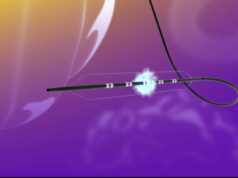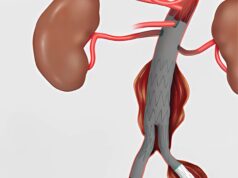Michael Gough, Leeds General Infirmary, Leeds, UK, presented long-term follow-up after endovenous laser ablation for great saphenous varicose veins at the 34th Charing Cross International Symposium in London, UK. The study reviewed a group of 63 patients (79 limbs) 6.5 years after above-knee laser treatment.
“Current techniques for endovenous ablation have changed, but at the time we were only ablating the above-knee great saphenous vein regardless of whether there was above- and below-knee reflux or not. The follow-up was done with ultrasound, Aberdeen Varicose Vein Severity Score (AVVSS) and CEAP grade,” Gough said.
He told delegates that the ultrasound findings showed “very satisfactory” results in the reduction of full above-knee great saphenous vein reflux and groin neovascularisation.
“The commonest abnormality was persistent below-knee reflux. Nowadays that is easily dealt with because we would always ablate an incompetent below-knee great saphenous vein at the initial treatment. So that is not a problem. However, we did find that quite a few patients presented with segmental great saphenous vein reflux or with reflux at the sapheno-femoral junction. These patients are more problematic” he noted.
In terms of varicose vein reflux, the ultrasound results showed that 53% of limbs (42/79) had recurrent incompetence. When looking at patients, the recurrent varicose vein rate was lower, with 33% (21/63) reporting their presence. Seventy three per cent of the patients (45/62) considered the treatment successful and 80.6% (50/62) would have endovenous laser treatment again.
“In terms of the ultrasound recurrence, why had patients developed recurrent varicose veins? Most of them were because of progressive disease such as perforators, below-knee reflux, anterior or posterior thigh vein or pelvic varicosities. Nevertheless, a proportion were due to a failure of the original treatment,” Gough said.
He added that, despite that, quality of life improvements persisted at six years. “So when we take into consideration patients’ views on their recurrence and on repeat treatment, we have quite satisfactory results,” he stated. “Most recurrences were due to progressive disease, and two-thirds of these were suitable to further endovenous therapy. Neovascularisation, as we always suspected, was much less (14%) than with an equivalent group after surgery (54%) at five years.
The improvement in CEAP grade and quality of life was maintained.
“Persistent below-knee reflux was the commonest finding and we now treat it from the outset as we know that it reduces the risk of residual varicose veins after the initial treatment. As far as the group with segmental reflux and sapheno-femoral junction reflux is concerned, it is tempting to suggest that a 1470nm radial fibre may reduce the risk of this happening but of course we have to await further data.”












